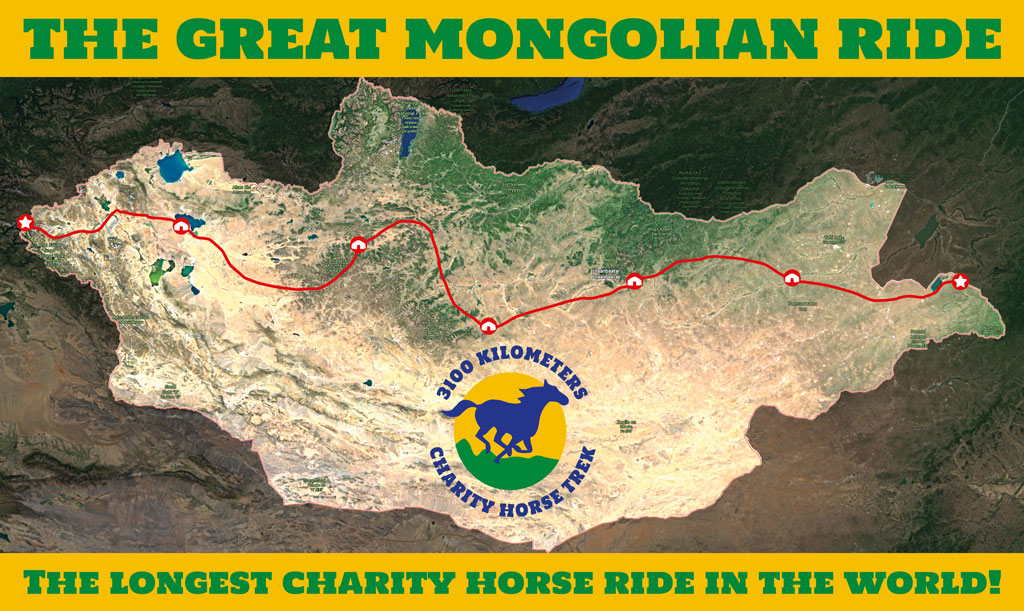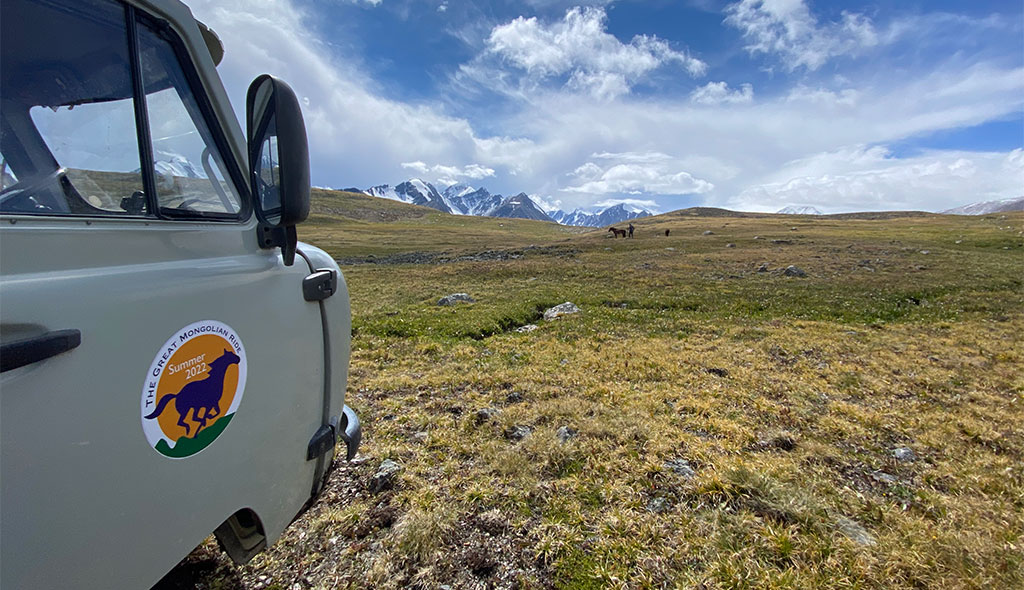
3100 kilometres on horseback through Mongolia
By Regula Sandi, translated from German by Jessica Finders
Nowhere else can you experience endless wilderness, tranquillity and pristine nature in such concentrated power as during a horse trek in Mongolia – and donate to a good cause at the same time. 13 riders took part in the “Great Mongolian Ride”, possibly the longest charity ride in the world, raising money for the dental health of Mongolian children. 3100 kilometres over high mountains and through endless steppe. A field report.
We are in the most Western parts of Mongolia, far away from civilization, in the Altai Mountains at 3000 meters above sea level. This is where the “Great Mongolian Ride” begins. Wafts of mist drift across the plateau where our horses graze. It is cold. With clammy fingers we grab the reins of our mounts, which will carry us henceforth at little further east every day. “Yawee! Let’s go!” call Sumbe and Baagii, our Mongolian guides, gesturing towards the horizon. This is the sign of our departure.
We travelled to Mongolia to experience an unforgettable adventure, but also to support a good cause; 20 percent of the proceeds from the ride went directly to the “Misheel Kids Foundation”, a foundation committed to the dental health of disadvantaged children in Mongolia. “Misheel” is a Mongolian word meaning “bright smile”. Alerted by the poor dental wellbeing of many Mongolian children, Gabriella Schmidt-Corsitto, a qualified Swiss dental hygienist and initiator of the “Great Mongolian Ride”, set up the foundation in 2015 together with Mongolian dentist Dr. Anuudari Erkhembaatar. The organization treats children who have no other access to dental care, teaches them oral hygiene and educates them on the connection between nutrition and dental health. The idea for the charity ride across Mongolia was born out of a commitment to children’s dental health and a passion for horses. Together with the local family business “Saraa’s Horse Trek Mongolia”, Schmidt-Corsitto, herself an enthusiastic rider, set up one of the greatest adventures for horse lovers from all over the world.
First at a walk, then at a trot, we move through the cloud-covered, mystical-looking mountain landscape, home to the secretive wolves and bears of the region. We sit on small, sturdy Mongolian horses. The animals are extremely resilient and have enormous endurance. Like our local guides, Gabriella Schmidt-Corsitto rides on a traditional Mongolian saddle, which is made of a high wooden seat covered with fine colourful fabric. Artful silver ornaments are emblazoned on the right and left of the saddle. The rest of us sit on Russian saddles made of tough leather stretched over a wooden frame, sometimes padded with a sheepskin.
We dive deeper and deeper into the landscape. In the distance, a glacier pushes its way through a valley between high, snow-capped mountains. If it weren’t for the bay, dun, grey and piebald horses to my right and left, I almost feel like I’m in Switzerland. We are traveling with a herd of 23 horses. Closely packed together, they trot alongside us. When need be, the guides catch them with an Uurga, a type of lasso at the tip of a long wooden pole. The others run free. On average, we cover 50 kilometres in one day, sometimes more, and we ride into the evening. We pitch our tents depending on where there is enough grass and water for the horses.
What is for us a unique and quite strenuous experience, is for the Mongols an integral part of their culture. Since time immemorial, they have moved as nomads with their animals from pasture to pasture. For a long time, horseback riding was the only way to move efficiently across this vast land. Genghis Khan’s empire, which stretched from the China Sea to Eastern Europe, was built on horseback. The Mongolian people are proud of their history and still revere the famous conqueror. A variety of cultural events such as horse races, wrestling matches, archery and ritual dances are dedicated to him.
The landscape in front of us becomes increasingly flat and arid. To the swaying rhythm of the horses, we soon trot across treeless, endless steppe. Above us a bright blue sky, around us seemingly limitless space. The weather is dominated by the continental climate. One moment the icy wind blows against us, the next moment the sun beats the sweat off our foreheads. The summer is short. Winters are long and hard. We are exposed to the forces of the elements, and at the same time merge into them. I get a taste of the hardships of life brought by this wilderness, but also the intense moments of happiness.
Traditional nomadism is still widespread in Mongolia and a large part of the population lives from cattle breeding. Goats, sheep, horses, camels or yaks are sources of income and at the same time supply. But the livelihood of the nomads is threatened. Due to climate change, mining and overgrazing, the desert is spreading more and more. The animals find too little food and die during the harsh winter months. In search of a better life, more and more nomads settle with their belongings outside the gates of the capital Ulaanbaatar. Often they live there in precarious conditions, find no work and are confronted with new challenges. Thousands of children suffer from this situation and are often affected by homelessness and malnutrition at a young age. Numerous orphanages and day care centers have sprung up in the capital to try to alleviate the plight of the youngest children. The “Misheel Kids Foundation” visits these facilities and carries out dental treatments free of charge. In addition, the children receive tooth brushing instructions.
“When children learn how to take care of their own teeth, they experience self-reliance. This also has a positive effect in other areas of their lives,” explains Gabriella Schmidt-Corsitto confidently. Her commitment is based on years of experience. In the 1980s, she set up a mobile dental clinic for the Albert Schweizer Hospital in Gabon, Central Africa, and cared for hundreds of disadvantaged children in remote regions. After that, she lived with her family in various other African countries. She has now been at home in Mongolia for almost ten years and works with the “Misheel Kids Foundation” to promote the dental health of Mongolian children. She also rides whenever possible and accompanies “Saraas Horse Trek Mongolia” on guided horse treks for tourists who are enthusiastic about equestrian sports. A part of the proceeds goes to the foundation. The “Great Mongolian Ride” is her long-held dream come true.
As participants, we are allowed to share in the realization of this dream. In 64 days, divided into six stages, the trek leads from the West to the East across the entire country. Every ten days there is a rest day. While we are exclusively on horseback, escort vehicles transport our sleeping tents, a Ger (the traditional Mongolian round tent, also called a yurt), our luggage and the food. It is a simple life that we lead during these days. We bathe in rivers and crystal-clear lakes and do our business in the steppe. The comfort of the western world is far away. The constant outdoor living in wind and weather, and the many hours in the saddle sap our strength. But it is also a nice feeling to snuggle up in your sleeping bag in the evening, exhausted, listening to the silence. There is no traffic here, no noise. The only thing we hear is the mewling sound of grazing horses around our tents. Or a roaring yak in the distance.
Every day we ride a different horse. That’s quite challenging, as each horse has its own character. But soon we know the quirks and merits of each one. Sometimes we change horses several times a day. Then we watch, fascinated, as the guides, Sumbe and Baagii, try to catch our new mounts – not an easy task. After all, these animals roam freely in the steppe most of the time and are not as docile as our European riding horses.
It is beautiful to observe the animals displaying their natural behaviour, and to be with them on the move in this breath-taking landscape. As riders we can rely on them. They carry us safely over narrow mountain passages, steep downhill, and sharp climbs. We cross rivers and swamps, scour forests and wide valleys. Sometimes the ground is covered with lush green grass, sometimes with the finest sand. Sometimes our gaze finds no points of orientation in the endless expanse, sometimes bizarre rock formations tower up before us. In the changing game of light and shadow, our surroundings take on new colours and contours time and again.
On the way we meet nomadic settlements. These consist of a community of several Gers. The traditional dwelling of the Mongols is built with a circular wooden frame, over which a felt mat, a cotton cover and a waterproof tarpaulin are stretched. In the centre is a stove, in the back are artistically painted wooden chests in which personal belongings are stored. Beds are placed along the side walls. During the day they are used as sofas. Horses and herds of goats or yaks graze around the Gers, sometimes numbering several hundred animals. The inhabitants are curious. They invite us for milk tea and hand us aarol, dried yogurt. The hospitality of the people is heart-warming. These are unforgettable moments that we experience like this, on the road with the horses, in the endless wilderness of Mongolia. We came because we were looking for an adventure. We found much more.
Horse riding for Mongolian children
The “Great Mongolian Ride” took place from July 20 to September 23, 2022. In 64 riding days, divided into 6 stages, 13 participants covered 3100 kilometers across the whole Mongolia. The author of the text participated in the first and second stage. “Saraa’s Horse Trek Mongolia” conducts horse treks for riders of all levels throughout the year, supporting the “Misheel Kids Foundation“.


